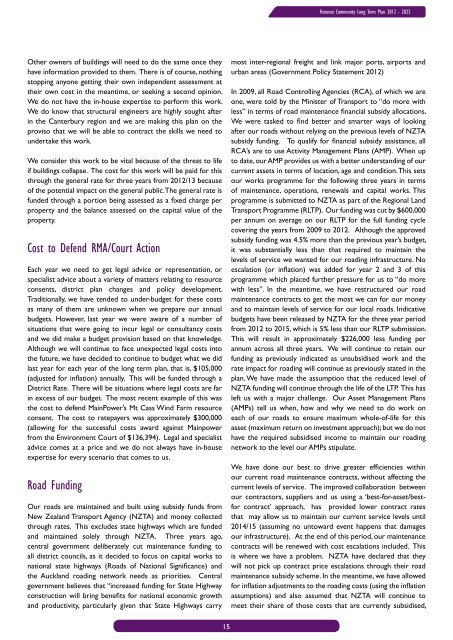Draft Long Term Plan 2012-2022 - Hurunui District Council
Draft Long Term Plan 2012-2022 - Hurunui District Council
Draft Long Term Plan 2012-2022 - Hurunui District Council
You also want an ePaper? Increase the reach of your titles
YUMPU automatically turns print PDFs into web optimized ePapers that Google loves.
<strong>Hurunui</strong> Community <strong>Long</strong> <strong>Term</strong> <strong>Plan</strong> <strong>2012</strong> - <strong>2022</strong>Other owners of buildings will need to do the same once theyhave information provided to them. There is of course, nothingstopping anyone getting their own independent assessment attheir own cost in the meantime, or seeking a second opinion.We do not have the in-house expertise to perform this work.We do know that structural engineers are highly sought afterin the Canterbury region and we are making this plan on theproviso that we will be able to contract the skills we need toundertake this work.We consider this work to be vital because of the threat to lifeif buildings collapse. The cost for this work will be paid for thisthrough the general rate for three years from <strong>2012</strong>/13 becauseof the potential impact on the general public. The general rate isfunded through a portion being assessed as a fixed charge perproperty and the balance assessed on the capital value of theproperty.Cost to Defend RMA/Court ActionEach year we need to get legal advice or representa tion, orspecialist advice about a variety of matters relating to resourceconsents, district plan changes and policy de velopment.Traditionally, we have tended to under-budget for these costsas many of them are unknown when we prepare our annualbudgets. However, last year we were aware of a number ofsituations that were going to incur legal or consultancy costsand we did make a budget provision based on that knowledge.Although we will continue to face unexpected legal costs intothe future, we have decided to continue to budget what we didlast year for each year of the long term plan, that is, $105,000(adjusted for inflation) annually. This will be funded through a<strong>District</strong> Rate. There will be situations where legal costs are farin excess of our budget. The most recent example of this wasthe cost to defend MainPower’s Mt Cass Wind Farm resourceconsent. The cost to ratepayers was approximately $300,000(allowing for the successful costs award against Mainpowerfrom the Environment Court of $136,394). Legal and specialistadvice comes at a price and we do not always have in-houseexpertise for every scenario that comes to us.Road FundingOur roads are maintained and built using subsidy funds fromNew Zealand Transport Agency (NZTA) and money collectedthrough rates. This excludes state highways which are fundedand maintained solely through NZTA. Three years ago,central government deliberately cut maintenance funding toall district councils, as it decided to focus on capital works tonational state highways (Roads of National Significance) andthe Auckland roading network needs as priorities. Centralgovernment believes that “increased funding for State Highwayconstruction will bring benefits for national economic growthand productivity, particularly given that State Highways carrymost inter-regional freight and link major ports, airports andurban areas (Government Policy Statement <strong>2012</strong>)In 2009, all Road Controlling Agencies (RCA), of which we areone, were told by the Minister of Transport to “do more withless” in terms of road maintenance financial subsidy allocations.We were tasked to find better and smarter ways of lookingafter our roads without relying on the previous levels of NZTAsubsidy funding. To qualify for financial subsidy assistance, allRCA’s are to use Activity Management <strong>Plan</strong>s (AMP). When upto date, our AMP provides us with a better understanding of ourcurrent assets in terms of location, age and condition. This setsour works programme for the following three years in termsof maintenance, operations, renewals and capital works. Thisprogramme is submitted to NZTA as part of the Regional LandTransport Programme (RLTP). Our funding was cut by $600,000per annum on average on our RLTP for the full funding cyclecovering the years from 2009 to <strong>2012</strong>. Although the approvedsubsidy funding was 4.5% more than the previous year’s budget,it was substantially less than that required to maintain thelevels of service we wanted for our roading infrastructure. Noescalation (or inflation) was added for year 2 and 3 of thisprogramme which placed further pressure for us to “do morewith less”. In the meantime, we have restructured our roadmaintenance contracts to get the most we can for our moneyand to maintain levels of service for our local roads. Indicativebudgets have been released by NZTA for the three year periodfrom <strong>2012</strong> to 2015, which is 5% less than our RLTP submission.This will result in approximately $226,000 less funding perannum across all three years. We will continue to retain ourfunding as previously indicated as unsubsidised work and therate impact for roading will continue as previously stated in theplan. We have made the assumption that the reduced level ofNZTA funding will continue through the life of the LTP. This hasleft us with a major challenge. Our Asset Management <strong>Plan</strong>s(AMPs) tell us when, how and why we need to do work oneach of our roads to ensure maximum whole-of-life for thisasset (maximum return on investment approach); but we do nothave the required subsidised income to maintain our roadingnetwork to the level our AMPs stipulate.We have done our best to drive greater efficiencies withinour current road maintenance contracts, without affecting thecurrent levels of service. The improved collaboration betweenour contractors, suppliers and us using a ‘best-for-asset/bestforcontract’ approach, has provided lower contract ratesthat may allow us to maintain our current service levels until2014/15 (assuming no untoward event happens that damagesour infrastructure). At the end of this period, our maintenancecontracts will be renewed with cost escalations included. Thisis where we have a problem. NZTA have declared that theywill not pick up contract price escalations through their roadmaintenance subsidy scheme. In the meantime, we have allowedfor inflation adjustments to the roading costs (using the inflationassumptions) and also assumed that NZTA will continue tomeet their share of those costs that are currently subsidised,15
















